Where Is the Church in the Old Testament?
Posted: January 3, 2021 Filed under: Uncategorized | Tags: Church, Easter, Jesus, logos, Passover, typology Leave a commentLately many people are asking, in these troubled times, where is the Church in the Old Testament? More questions soon follow regarding the Rapture and the Tribulation. They echo the age-old question: where is Christ in the OT? The early Apologists like Justin tried to find answers to the latter question in Greek philosophy, and came up with the Logos concept. They spawned a great deal of speculation regarding the nature of God and about theophanies (appearances) of God to Man in the OT. Were they of the transcendent God they deemed unapproachable or the preincarnate Christ they deemed immanent (accessible) to Man? The debate over theophanies continues to this day and in some minds calls into question the concept of the Trinity.
Similarly the Early Church, having forgotten the charismatic nature of the Apostolic Church and replaced it with institutionalism, sought to establish itself as the instrument and intended outcome of God’s purpose. Hence Millennialism (Chiliasm) and anticipation of a Rapture were suppressed; if God’s Kingdom is manifest today in Rome, said the bishops, then OT prophecies of a Millennial Kingdom ruled directly by Christ must be mere metaphor describing the Catholic Church ruled by the Pope in Christ’s stead. The de facto existence of the institutionalized Church, then, became through circular reasoning their proof of divine origin and intention.
Other theologians, beginning with Paul in the New Testament, applied the principles of Type and Antitype to see OT figures and prophecies through the lens of later fulfillment. Thus Melchizedek was a type of Christ as eternal high priest, David a type of Christ as conquering king, and Israel a type of the Kingdom of God on Earth, each provided by God for our examples.
An examination of the formative documents of historic Israel, known collectively as Moses’ Law, reveals remarkable correspondence between Mosaic Israel (as Type) and both Christ and the Church (as Antitype). Arguably the most central elements of Mosaic Law, after the Ten Commandments, are the several prescribed “feasts” or observances in which participation was mandatory for every Israelite. Technically, Leviticus 23 describes seven feasts, but due to overlapping, some descriptions consolidate them into as few as three (Ex. 23:14). The annual calendar of feasts is as follows:
| Nisan 10 | Selection of a male Passover lamb |
| Nisan 14 | Passover |
| Nisan 15 | Feast of Unleavened Bread (7 days) |
| Nisan 16 | Feast of First Fruits |
| 50 Days after Passover | Feast of Weeks (Pentecost) |
| Tishri 1 | Feast of Trumpets |
| Tishri 10 | Day of Atonement |
| Tishri 15 | Feast of Tabernacles (7 days) |
The sacrifice of a lamb commences Passover, typifying the sacrifice of Jesus (Jn. 1:29, 36; 1 Cor. 5:7); and it should not surprise informed Christians that the painting of the lamb’s blood on one’s doorposts and lintel prefigures deliverance from judgment through the covering of the blood of Jesus (1 Pet. 1:2, 19, etc.). The Hebrews were commanded further to purge leaven, a figure later used by Jesus and Paul to typify sin and hypocrisy, from their households and eat only unleavened bread for seven days.
Moreover, the Passover supper itself, replete with memorials to the Exodus, serves well as a Type repurposed by the incarnate Jesus into his Last Supper observance (Christ himself being the Lamb) with symbols of his shed blood and broken body to be ever-after observed as The Lord’s Supper (“in remembrance of me”).
Another Feast identified as a Type, to which few could object, is the Day of Atonement. On this day the high priest would select two unblemished goats. As the representative of the nation, the high priest would sacrifice one goat for the people’s corporate sins. Then he would lay his hands on the head of the other goat to identify it with the sins of the nation. This Scapegoat would be released into the wilderness, to carry the nation’s sins away to be willfully lost in the land of forgetfulness. “As far as the east is from the west, so far hath he removed our transgressions from us” (Ps. 103:12). Third-century bishop Cyprian of Carthage, holding an especially high view of his seat, compared his annual observance of the Eucharist in behalf of the people to that of Israel’s high priest on the Day of Atonement.
D. L. Moody associate C. I. Scofield noted that during the Feast of Unleavened Bread, as it coincided with the Feast of First Fruits, Hebrews were to offer a sheaf of grain to God in the form of a “wave offering.” The “wave” symbolized substitution. First Fruits, a vital concept in tandem with that of the Firstborn, prefigures not only Christ’s substitution for us but his Resurrection as Firstborn and Firstfruits of the dead (1 Cor. 15:20, Col. 1:18). Note that First Fruits occurs on the third day after Passover (by some reckonings), foreshadowing Christ’s Resurrection on the third day.
Scofield also observed the transition from unleavened bread to leavened wave loaves at the Feast of Weeks (Pentecost), 50 days (a “sabbath of sabbaths”) after First Fruits. He proposed that the leavened bread represents the consolidation of Christ’s Church into one entity. “For we being many are one bread, and one body: for we are all partakers of that one bread” (1 Cor. 10:17). This, in spite of it being mixed with sin/leaven. We are told elsewhere that the “sheep and goats” in the Church will finally be separated only at the End (Mt. 25, 1 Cor. 3, 2 Cor. 5:10). The Day of Pentecost recorded in Acts 2 is widely regarded as the inauguration of the Church, by virtue of its broad empowerment by the Holy Spirit. The Church, though not by nature perfect before God, is made acceptable and fruitful by a sovereign act of grace.
In the seventh month, Tishri, the Feast of Trumpets calls the people together for a commemoration. To Scofield this feast foreshadows the regathering of Israel for End-Time events. “Can these bones live?” the Spirit asked Ezekiel (37:3). On the tenth day of the month the people were to solemnly repent of their sins, afflicting their souls and observing the sacrifice of the Atonement, described earlier. Finally, the first day of the Feast of Tabernacles is a harvesttime celebration spanning seven days. The first day, the people are commanded to celebrate deliverance from bondage with palm and tree branches in a manner that in the Gospels was spontaneously applied also to Jesus’ triumphal entry into Jerusalem before Passover, declaring “Hosanna! Blessed is he that cometh in the name of the Lord: Blessed be the kingdom of our father David, that cometh in the name of the Lord! Hosanna in the highest!” (Ps. 118:26, Mk. 11:9-10). While Jesus’ entry occurs at Passover and not during Tishri, the association of the arrival of a new prophet and healer (Mt. 21:46, Jn. 12:18) with the deliverance of a renewed Davidic kingdom nevertheless suggests an expectation of prophetic fulfillment of the Feast of Tabernacles.
We see therefore that by fulfilling an OT prophetic Type, Jesus came to fulfill the Law, not to destroy it; moreover, “that all things must be fulfilled, which were written in the law of Moses, and in the prophets, and in the psalms, concerning me” (Lk. 24:44).
See also:
https://biblequestion.wordpress.com/2011/05/25/the-old-testament-in-the-new-what-is-true-typology/
https://biblequestion.wordpress.com/2010/04/02/131/
https://biblequestion.wordpress.com/2020/08/30/on-typology-cyrus-the-great-president-donald-trump/
Copyright 2021 Paul A. Hughes
On Typology, Cyrus the Great, & President Donald Trump
Posted: August 30, 2020 Filed under: Uncategorized 2 Comments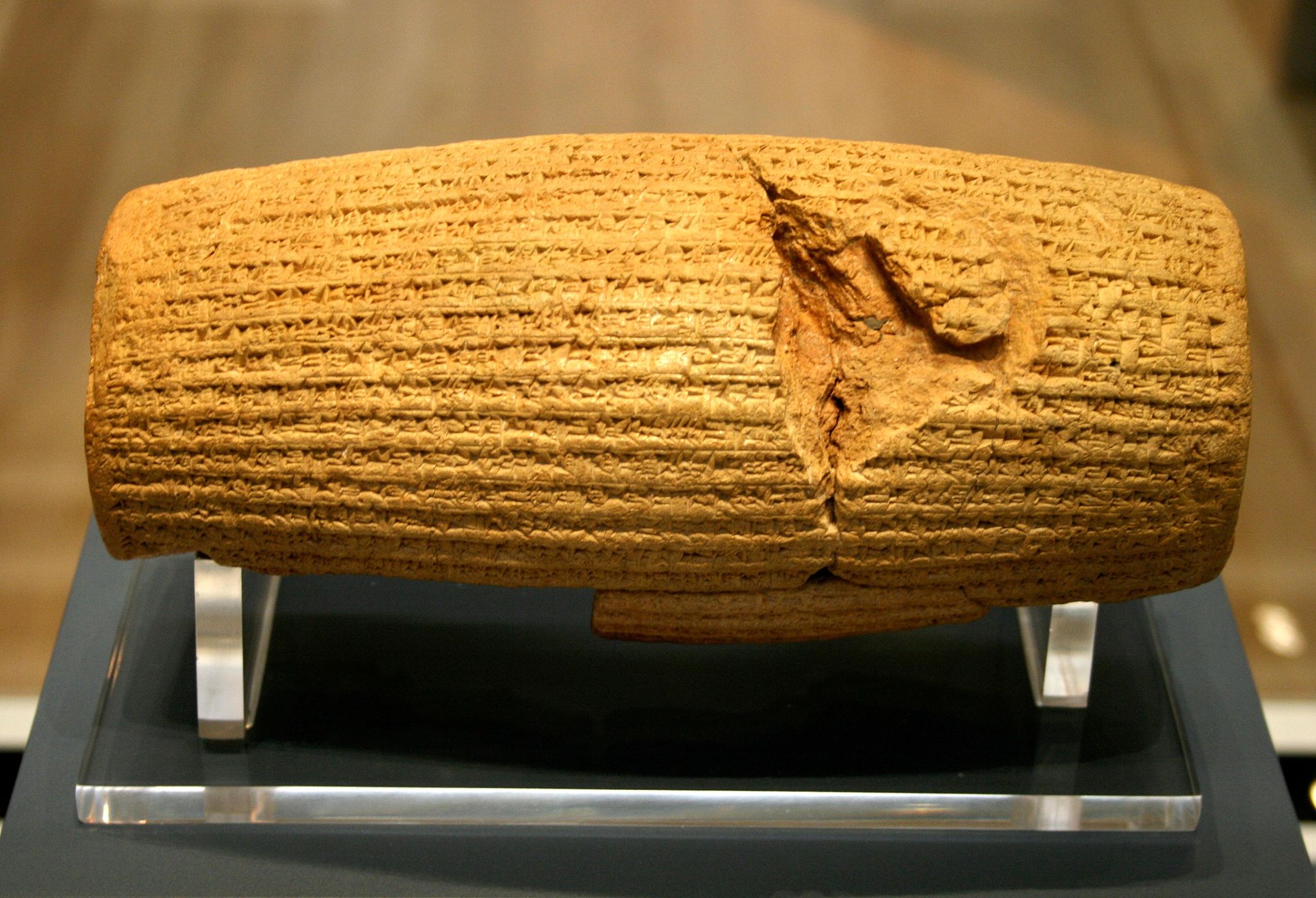
Cyrus the Great Cylinder
A critic of President Donald J. Trump wrote on a Christian site, “It also seems that the original prophecies that claimed that Trump was the new ‘Cyrus’ to bring about a restored Christian America have proven false, and should be recognized as false prophecy.”
I replied,
Tell me how this has been “disproved.” I do not think you can make this claim with any viability; it is just one opinion, unless you are claiming your own gift of discernment.
Integral with prophecy is typology. Many OT figures can be safely regarded as prophetic types because their antitypes are laid out in the NT. The Cornerstone laid in Zion is Christ, who is also the Rock and the Cloud in the Wilderness. Moses is clearly a type of Christ as deliverer, and David a type of Christ as conquering king. Did Jesus identify Lucifer as the being He saw fall from heaven? Many commentators have thought so.
Many other types have been proposed, including some for which the antitype cannot be found within the canon. Still lack of antitype within the canon does not preclude the future discovery of an antitype. Is Nero, though not named in Revelation 13, a type of Antichrist yet to come? One may conclude so.
Nor does every type/antitype relationship have to be what we would deem officially “prophetic” in the charismatic sense. Abraham is a type of follower of God who receives a promise, believes it, and is credited with righteousness. Such application of Scripture by analogy goes back to OT times and remains a staple of common preaching. It is reliance on examples of “men of old” found especially in Hebrews 11. It is how “whatsoever things were written aforetime were written for our learning, that we through patience and comfort of the scriptures might have hope” (Romans 15:4). After Moses’ Law has been abolished, there is still analogy.
Hence it is no stretch to find in the person of Cyrus the Great, whom God called his Anointed, a type or analogy of an initially unbelieving king who deals amenably with God’s People and is the instrument God has chosen for his work. Cyrus was the Game-Changer, the Deal-Maker who served God’s purpose.
(Cyrus could not be God’s Anointed = a Type of Christ because he was a foreign king coming out of unrighteousness.)
Similarly, Nebuchadnezzar was God’s instrument, whom God called “my servant,” but for the purpose of harsh judgment.
Therefore, the very least one must admit is that Donald Trump is a Cyrus figure by analogy — if not moreover an official, prophetic type — of ruler stemming from outside of God’s People who nevertheless regards their concerns and enacts help and deliverance in their behalf.
But unless one purports to speak prophetically for God against it, until the whole process at work in the world today comes to fruition, and unless the conclusion is self-evident, the question of President Trump as a “type” of Cyrus, prophetically, remains open.
[End of reply]
Note on the Cyrus Cylinder
On his cuneiform cylinder Cyrus declares an end to slavery. In addition, he writes,
“Today I declare Freedom of Religion. All are free to choose any religion, live in all regions and take up any job provided that they never violate other’s rights.”
Copyright 2020 Paul A. Hughes
How Neoplatonism Got to Florence and England
Posted: January 1, 2020 Filed under: Uncategorized Leave a comment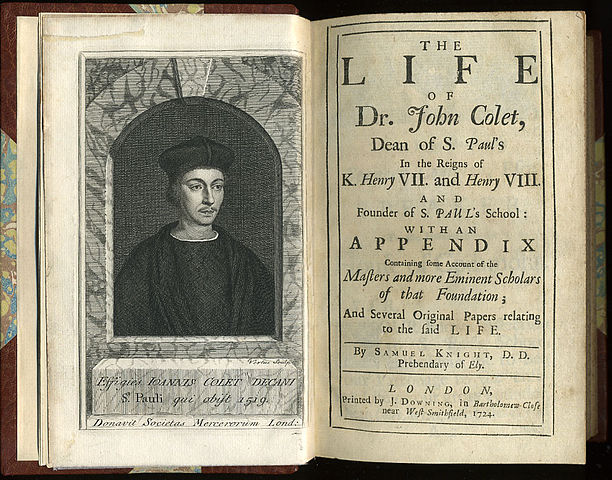
John Colet, Dean of St. Paul’s School
How two churchmen in Florence opposed Aristotle by preaching Plato; and how John Colet took the message back to England
From J. H. Lupton, editor, Two Treatises on the Hierarchies of Dionysius by John Colet (London: Bell and Daldy, 1869).
(pp. xv-xvi)
A German essayist on [Psuedo-]Dionysius,* Augustus Meier, is probably right in saying, that mysticism chiefly springs up and flourishes, when the established forms of religion have begun to lose their hold on men; when the instinctive longing of the soul after the immortal and divine remains, but can find nothing to satisfy it in the external rites of a failing church. “From the hard and arid system of Peter the Lombard,” says Milman, “the profound devotion of the Middle Ages took refuge in mysticism.”
(p. xvi)
It was the sight of a letter of Erasmus’s to Robert Gaguin, the French historian, that first introduced Erasmus to the notice of [John] Colet. The practice of handing letters about, as evidences of scholarship, seems at that time to have been common; and Gaguin had in this manner shewn to Colet one received by him from Erasmus. The fact would seem to betoken a certain amount of intimacy between Gaguin and Colet. Now Gaguin, a man of letters, and the enviable possessor of a well-stocked library, was in correspondence with [Marsiglio] Ficino. In his collected Letters there is one addressed to the Florentine scholar, dated Sep. 1st, 1496 in which he compliments Ficino on the extent to which his writings were then read in Paris. His translation of Plotinus, he says, and other treatises of his, were so popular and so highly esteemed, that many a French scholar was eager “to know by sight and to gaze upon a man, from whom issued forth such noble memorials of learning.”
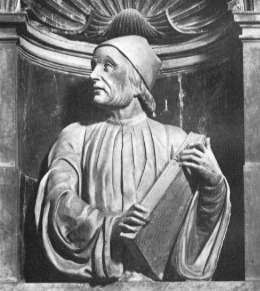
Marsiglio Ficino
(p. xix)
Supposing now Colet to have taken up this new work of the learned Abbot of Spanheim, with the curiosity of a young student, and the deference naturally paid to the latest authority, how would he have found [Psuedo-]Dionysius spoken of? As the convert of St. Paul; of surpassing holiness and incomparable learning; as probably the first Bishop of Athens, and certainly the apostle of France; as the author, lastly, of many illustrious works.
(pp. xix-xx)
THE Council of Florence, held under the presidency of Eugenius IV., which had for its chief object the reconciliation of the Greek and Latin Churches, and which closed its deliberations in April 1442, has generally been considered to be the means through which the Platonic philosophy was introduced once more into Europe. But in reality Plato had been known to Italians a century before. Petrarch, who died in 1374, and to whose zeal in collecting manuscripts the cause of learning was in no small degree indebted, had procured several copies of Plato’s works, partly in Latin translations, and partly in the original Greek. His guide in this pursuit was Barlaam, a Calabrian monk, the fortunate possessor of still more treatises of Plato. Boccaccio succeeded to the study, and read Plato in the library of his friend Petrarch.
(p. xxii)
“From this period” says M. Delecluze, “freedom of thought in Europe took its rise; and from this crude medley of profound erudition and mystic philosophizing sprang the taste for the study of the moral sciences, and general literature, which opened the way to philosophy and the sciences.”
(pp. xxiii-xxiv)
The three great objects of [Giovanni Pico della] Mirandola’s literary labours were, as Ficino informs us, the reconciliation of the Platonic philosophy with the Aristotelian; the explanation of the Holy Scriptures; and the confutation of astrology. The first of these objects he often alludes to in his extant letters. Thus, in one dated 1484, he speaks of having lately passed from the camp of Aristotle to that of the Academy, not as a deserter, but as a spy. …. In one passage of his great work, for instance, after describing the increase of Aristotle’s influence, which he attributes in part to the influx of the works of Averroes and Avicenna, rendered easier by the conquests of Ferdinand and Isabella, he details the efforts made by Pletho and Bessarion to call attention to Plato; and then contrasts his relative’s endeavour to reconcile the two systems, with his own purpose of depreciating heathen philosophy altogether, when brought into rivalry with the doctrines of Christianity.
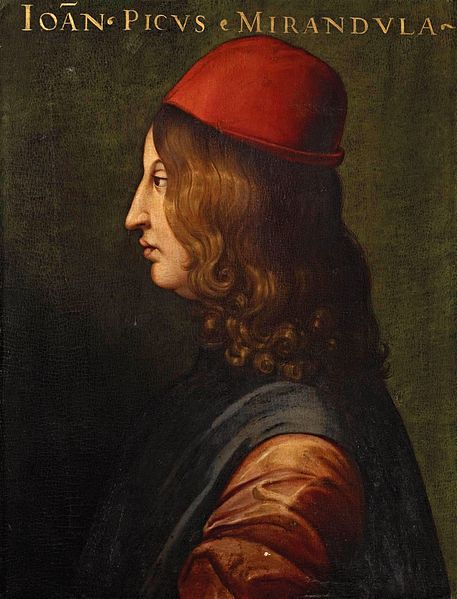
Giovanni Pico della Mirandola
…. It was through [Mirandola’s] entreaties that Ficino undertook the translation of Plotinus; an author whom Mirandola speaks of as worthy not only of constant perusal, but of being learnt by heart, and who appears to have led Ficino naturally on to Dionysius, as a translation of some of his works was the next task he took in hand.
(p. xxxi)
And so we are not surprised to learn that Ficino wrote a commentary on part of the Epistle to the Romans, nor that he publicly lectured on St. Paul, as Canon of the church of St. Lorenzo in Florence; nor finally that Colet, a student of Plato, Plotinus and Dionysius, lectured on St. Paul, on his return to Oxford.
*Pseudo-Dionysius, an anonymous monk steeped in the Neoplatonism of Plotinus, appeared about A.D. 500 and wrote several mystical works under the pseudonymn Dionysius the Areopagite, mentioned in Acts 17:34 as a follower of Paul. He has also been confused with the 3rd-century bishop and patron saint of Paris, Denis. For both these associations, Pseudo-Dionysius has in past centuries been accorded a nearly apostolic level of credibility, quite undeserved. ~Paul Hughes
How Platonic Philosophy became Religion
Posted: January 1, 2020 Filed under: Uncategorized Leave a comment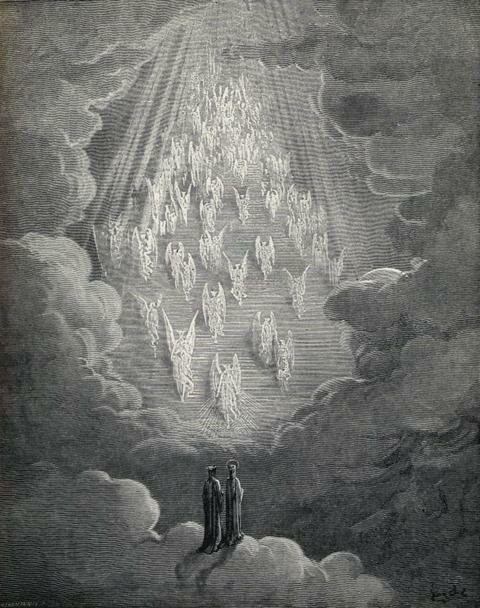
Public Domain
How Platonism in its search for ultimate truth and beauty evolved into Mysticism and Contemplative Prayer (Neoplatonism)
Excerpt from R. G. Bury, editor, The Symposium of Plato (Cambridge: W. Heffer and Sons, 1909), pp. xlviii-xlix, quoting Benjamin Jowett.
The philosopher is not only a student, he is also, by the necessity of his nature, a teacher. This is a point of much importance in the eyes of Plato, the Head of the Academy: philosophy must be cultivated in a school of philosophy.
The significance of Eros, as thus conceived, has been finely expressed by Jowett (Plato i. p. 532): “(Diotima) has taught him (Socr.) that love is another aspect of philosophy. The same want in the human soul which is satisfied in the vulgar by the procreation of children, may become the highest aspiration of intellectual desire. As the Christian might speak of hungering and thirsting after righteousness; or of divine loves under the figure of human (cp. Eph. v.32); as the mediaeval saint might speak of the ‘fruitio Dei’; as Dante saw all things contained in his love of Beatrice, so Plato would have us absorb all other loves and desires in the love of knowledge. Here is the beginning of Neoplatonism, or rather, perhaps, a proof (of which there are many) that the so-called mysticism of the East was not strange to the Greek of the fifth century before Christ. The first tumult of the affections was not wholly subdued; there were longings of a creature ‘moving about in worlds not realised,’ which no art could satisfy. To most men reason and passion appear to be antagonistic both in idea and fact. The union of the greatest comprehension of knowledge and the burning intensity of love is a contradiction in nature, which may have existed in a far-off primeval age in the mind of some Hebrew prophet or other Eastern sage, but has now become an imagination only. Yet this ‘passion of the reason’ is the theme of the Symposium of Plato.”
(d) Eros as Religion. We thus see how to “the prophetic temperament” passion becomes blended with reason, and cognition with emotion. We have seen also how this passion of the intellect is regarded as essentially expansive and propagative. We have next to notice more particularly the point already suggested in the words quoted from Jowett—how, namely, this blend of passion and reason is accompanied by the further quality of religious emotion and awe. We are already prepared for finding our theme pass definitely into the atmosphere of religion not only by the fact that the instructress is herself a religious person bearing a significant name, but also by the semi-divine origin and by the mediatorial role ascribed to Eros. When we come, then, to “the greater mysteries” we find the passion of the intellect passing into a still higher feeling of the kind described by the Psalmist as “thirst for God.” This change of atmosphere results from the new vision of the goal of Eros, no longer identified with any earthly object but with the celestial and divine Idea ([autokalon]). Thus the pursuit of beauty becomes in the truest sense a religious exercise, the efforts spent on beauty become genuine devotions, and the honours paid to beauty veritable oblations. By thus carrying up with her to the highest region of spiritual emotion both erotic passion and intellectual aspiration, Diotima justifies her character as a prophetess of the most high Zeus; while at the same time we find, in this theological passage of the Socratic [logoi], the doctrine necessary at once to balance and to correct the passages in the previous [logoi] which had magnified Eros as an object of religious worship, a great and beneficent deity.
This side of Diotima’s philosophising, which brings into full light what we may call as we please either the erotic aspect of religion or the religious aspect of Eros, might be illustrated abundantly both from the writers of romantic love-poetry and from the religious mystics.
(References follow to Edmund Spenser, Thomas Browne, Ralph Waldo Emerson, John Keats, among the romantic poets.)
The Eerily Familiar Story of John Chrysostom
Posted: November 3, 2018 Filed under: Church History | Tags: church fathers, church history Leave a comment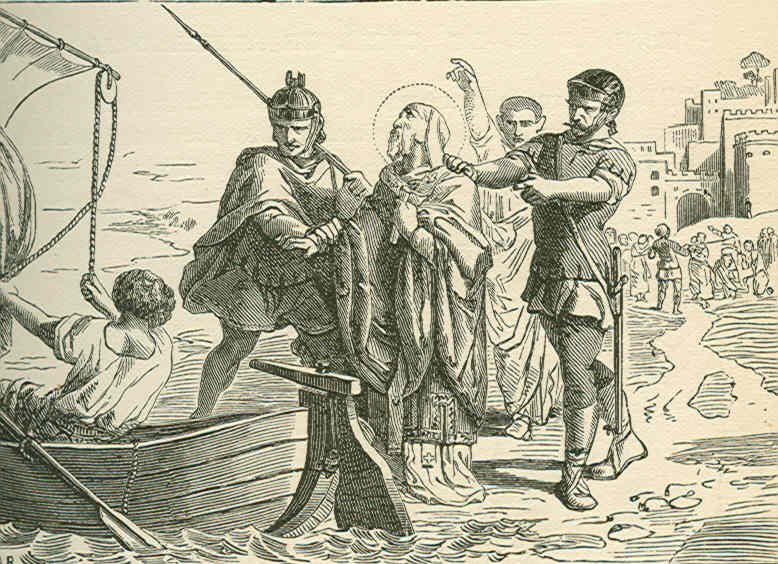
John Chrysostom Exiled from Constantinople
(According to Socrates Scholasticus, Ecclesiastical History)
When Nectarius bishop of Constantinople died, John (AD 349-407), a celebrated presbyter in Antioch, was chosen his successor by general assent. Due to the popularity of his sermons, he was accorded the nickname Chrysostom, which means “Golden Mouth.” However, Bishop Theophilus of Alexandria, who was supposed to ordain Chrysostom, tried to undermine his selection out of self-interest (EH 6.2).
Chrysostom often came off as proud and unfriendly to strangers, his moralistic and unguarded speech highly offensive to those he criticized (EH 6.3). His fellow clergy resented his apparent aloofness, having as he did the habit of eating alone and not attending feasts. Yet the people venerated Chrysostom for his sermons, which they found touching and engaging (EH 6.4).
Chrysostom drew the ire of the noble classes by his open criticism of them. He was blamed in particular for his unrelenting public rebuke of a certain well-connected malefactor named Eutropius, who appealed to “sanctuary” while cowering under the altar. (Later, Eutropius was beheaded by the Emperor.) Chrysostom was moreover called “rude” in his criticism of the Emperor’s top general, Gaïnas, for showing favor to the Arians (EH 6.5). Gaïnas, a Goth, later attempted a revolt and was killed (EH 6.6).
Theophilus hatched a plan to undermine Chrysostom and other supporters of the Homoousion (“same substance”) party by arranging the condemnation of all the books of the late Origen of Alexandria. For this he engaged a certain group of militant monks (EH 6.7). He also persuaded the venerable but gullible Bishop Epiphanius to call a synod in Cyprus to condemn Origen’s books (EH 6.10). Meanwhile, Chrysostom went to Ephesus to ordain a successor to the recently deceased bishop. While in Ephesus, he ousted various schismatic groups from their rival churches, for which he was later blamed (EH 6.11).
Epiphanius sailed to Constantinople and announced the decree of his synod; but certain upstanding clergy denounced his effort to smear the name of a Father long dead, whose works had long been revered, and by association Scripture, from which Origen’s principles had been drawn (EH 6.12). A general council was planned in which Epiphanius would condemn Origen’s books and level charges on Chrysostom and others; but Chrysostom sent a message warning Epiphanius of certain counter-charges to be leveled against him, along with the suggestion that he might be endangered by public rioting that he might expect to ensue. Epiphanius panicked and took ship home, but died on the return voyage (EH 6.14).
Chrysostom’s ultimate downfall began when he made a public criticism of women in general, which was widely regarded as an indirect attack on the Empress Eudoxia. The Emperor sanctioned a synod to be called at Chalcedon to charge Chrysostom. The synod was packed with his enemies, including the schismatic bishops he had deposed while in Ephesus. Theophilus was there, but was so openly hostile to Chrysostom that he was shunned by other clergy. Chrysostom refused to attend on the grounds that his enemies were not fit to judge him. In the end Chrysostom was deposed on a general charge of stubborn disobedience. Chrysostom slipped quietly out of town to avoid the brewing public uprising (EH 6.15).
One enemy, Severian, proclaimed that “If John had been condemned for nothing else, yet the haughtiness of his demeanor was a crime sufficient to justify his deposition.” After much public outcry, and partisan clashes in which some people were killed, the Emperor begged Chrysostom to return, to keep the peace. Theophilus and other hostile bishops fled home (EH 6.16, 17).
Finally Chrysostom openly criticized the holding of public games in honor of the Empress Eudoxia in close proximity to the Hagia Sophia church. When Chrysostom heard that Eudoxia called for another synod against him, he compared her in a sermon to Herodias, mother of Salome, who arranged for John the Baptist to be beheaded. So in the end the uncompromising John Chrysostom was ousted for good; still a party of his followers continued for some time under the name Johannites (EH 6.18).
Included amongst his more modern followers was John Wesley.
Copyright © 2018 Paul A. Hughes
Was the Inacarnate Jesus Limited by Time or Space?
Posted: July 16, 2018 Filed under: Church History, Historical Theology, Jesus, Theology Leave a commentThe question was asked whether Jesus while incarnate was limited by time or space.
The Church Fathers argued for centuries about whether Logos/Christ was actually God or the spoken expression of God (Monism, Monarchianism, Modalism); was the first of God’s Creation (labeled Arianism); or following Origen, was “eternally generated” from God; finally settling largely on the latter, differentiating “created” from “begotten.” For years, Arianism held sway (when Ulfilas converted the Goths, they were Arian), being supported by the Emperor (Valens, I think), but turned around with the help of Basil & the other Cappadocian Fathers.
Debate was cut short due to the Muslim conquests. It became the convention to regard Christ as having existed eternally and also begotten “before time,” as if there were no sequential events, before God through Christ created time along with the Universe. Personally, I see all time, like history, as a linear progression of events at a constant rate. That is the mode of events presented in the Bible, and the only reality that we know in this life. We can even conceive of eternity in the future; only the concept of eternity past, before life as we know it, eludes us.
From the Fathers on down to the Reformers, it was popular to think in terms of Christ governing the universe even while incarnate, since they wanted to vaunt Christ as much as possible, and had little comprehension of the purpose or nature of the Holy Spirit. The opposite view, that of Kenosis or “emptying,” has always been attacked as heresy. Theories have been floated such as the idea that the human Jesus did not contain all of Logos but only a manifestation thereof, which sounds to me a lot like the phone booth spaceship in which Dr. Who time-travels, which is much bigger on the inside than on the outside, and which he says does not literally exist in real space. But most rationalizations gravitate toward Docetism or semi-Docetism, that Christ only “seemed” to be human. Yet Docetism, as has often been pointed out, gives short shrift to Christ’s humanity and his suffering on the Cross.
The answer to the question boils down to how much sovereignty Christ exercised or possessed during Incarnation, versus how much He “emptied” (EKENWSEN, Phil. 2:7) himself. But since we do not and cannot know that, then we do not know the other, either. Nevertheless, people speculate based on their own preferences and dogmatic loyaties.
I would suggest that Christians spend much time as well as effort practicing those things that we are clearly taught, and little time speculating on those things which we are not given to know.
Copyright 2018 Paul A. Hughes
Bibliography of ‘Christian’ Neoplatonism
Posted: June 20, 2018 Filed under: Church History, Historical Theology, Mysticism, Theology Leave a commentI have assembled this brief bibliography of Christianized Neoplatonism, which was introduced into Christian theology and practice through the Hellenistic schools, beginning in Alexandria as early as the late Second Century, by persons including Clement and Origen, and re-introduced periodically through such figures as Evagrius, Augustine, Pseudo-Dionysius, and Gregory, on down to Thomas Aquinas, the German mystics, and John Wesley. This phenomenon was uncovered, in particular, by some of the great 19th- and early 20th-century scholars. Yet Neoplatonist doctrines and practices continue to be defended by certain denominations, including Roman Catholics and Anglicans, who claim that while the Church Fathers and later theologians found it necessary to use Neoplatonist categories and terminology, they were not actually influenced by Neoplatonist ideas.
Angus, Samuel, The Sources of the First Ten Books of Augustine’s De Civitate Dei, A Thesis Presented to the Faculty of Princeton University for the Degree of Doctor of Philosophy (Princeton, 1906)
“Augustine’s Confessions as Neoplatonic Ascent,” http://www.sparknotes.com/philosophy/confessionsaug/
Bigg, Charles, Neoplatonism (London: Society for Promoting Christian Knowledge, 1895)
Bigg, Charles, and Fr. E. Brightman, The Christian Platonists of Alexandria, Bampton Lectures of the Year 1886 (Oxford: Clarendon Press, rpt. ed. 1913)
Christensen, Michael J., “Theosis and Sanctification: John Wesley’s Reformulation of a Patristic Doctrine,” Wesleyan Theological Journal 31/2 (Fall 1996)
Dods, Eric R., “Tradition and Personal Achievement in the Philosophy of Plotinus,” in The Journal of Roman Studies, vol. 50/1-2 (1960), also in The Ancient Concept of Progress (Oxford University Press, 1973; rpt. ed. 2001)
Dods, Eric R., The Greeks and the Irrational (Berkeley and Los Angeles, CA: Univ. of California Press, 1951)
Dorner, Isaak. A., History of the Development of the Doctrine of the Person of Christ, Div. 1, vol. 1, trans. William L. Alexander and D. W. Simon, Clark’s Foreign Theological Library, 3d series, vol. 11 (Edinburgh: T. & T. Clark, 1872), pp. 285-303
Elsee, Charles, Neoplatonism in Relation to Christianity (Cambridge, 1908)
Fairweather, William, Origen and Greek Patristic Theology (NY: Scribner’s, 1901)
Goldie, Mark, “Cambridge Platonists (act. 1630s–1680s),” Oxford Dictionary of National Biography, Oxford University Press, Sept 2013, http://www.oxforddnb.com/view/theme/94274
Gore, Charles, Dissertations on Subjects Connected with the Incarnation, 2 vols. (London: John Murray, 1895), pp. 171-76
Guthrie, Kenneth S., Numenius of Apamea, the Father of Neo-Platonism (London: George Bell and Sons, 1917)
Halliday, William R., The Pagan Background of Early Christianity (Liverpool: The University Press of Liverpool, 1925)
Hodge, Charles, Systematic Theology, vol. 2 (NY: Scribner, Armstrong, and Co., 1877), pp. 65 ff., 157 ff., 582-91
Hort, Fenton J. A. and Joseph B. Mayor, Clement of Alexandria, Miscellanies, Book 7 (London: Macmillan, 1902)
Hughes, Paul, Neoplatonist Stew: Or, How Sacramentalism, Mysticism, and Theurgy Corrupted Christian Theology (Liberty, TX: God’s Trombone, 2014)
Hughes, Bren, “Origen and the Incorporation of Platonic/Apophatic Theology into the Christian System” (2005), http://www.brenhughes.com/Research/ApophaticTheology.pdf
Inge, William R., A History of Western Philosophy: And Its Connection with Political and Social Circumstances from the Earliest Times to the Present Day (NY: Simon and Schuster, 1945)
Inge, William R., Christian Mysticism, The Bampton Lectures (London: Methuen Co., 1899)
Inge, William R., Personal Idealism and Mysticism: The Paddock Lectures for 1906, (London: Longmans, Green, and Co., 1907)
Inge, William R., Studies of English Mystics: St. Margaret’s Lectures, 1905 (London: John Murray, 1906)
Inge, William R., The Philosophy of Plotinus, 2 vols. (London: Longmans, Green, and Co., 1918)
Inge, William R., The Religious Philosophy of Plotinus & Some Modern Philosophies of Religion (London: Lindsey Press, 1914)
Itter, Andrew C., Esoteric Teaching in the Stromateis of Clement of Alexandria (Leiden: Brill, 2009)
Itter, Andrew C., “Psuedo-Dionysian Soteriology and Its Transformation of Neoplatonism,” Colloquium 32/1 (2000)
Kaye, John, Some Account of the Writings and Opinions of Clement of Alexandria (London: Griffith Farran Okeden & Welsh, 1900)
Louth, Andrew, The Origins of the Christian Mystical Tradition: From Plato to Denys, 2d ed. (Oxford University Press, 2007)
Maddox, Randy L., “John Wesley and Eastern Orthodoxy: Influences, Convergences, and Differences,” Asbury Theological Journal 45/2 (1990)
McCormick, K. Steve, “Theosis in Chrysostom and Wesley: An Eastern Paradigm on Faith and Love,” Wesleyan Theological Journal 26 (1991):49-50
O’Meara, Dominic J., Platonopolis: Platonic Political Philosophy in Late Antiquity (Clarendon Press, 2003)
Parry, Thomas Jones, Augustine’s Psychology during his first period of literary Activity with special reference to his relation to Platonism (Borna-Leipzig: Buchdruckerei Robert Noske, 1913)
Patrick, John, Clement of Alexandria, The Croall Lecture for 1899-1900 (Edinburgh: William Blackwood & Sons, 1914)
Puhalo, Lazar, “The External Philosophy: The Fathers & Platonism” (2010), http://www.clarion-journal.com/files/platon.pdf
Robertson, David, Word and Meaning in Ancient Alexandria: Theories of Language from Philo to Plotinus (copyright David Robertson, 2008; publ. London: Routledge, 2016), https://books.google.com/books?id=CbiXCwAAQBAJ
Scott, Hugh M., Origin and Development of the Nicene Theology (Chicago: Chicago Theological Seminary Press, 1896)
Sharpe, Alfred Bowyer, Mysticism: Its True Nature and Value, 2nd ed. (London: Sands & Company, 1910)
Uebersax, John, “Christian Platonism and Christian Neoplatonism: Christian Platonists and Platonizing Christians in History” (List), http://www.john-uebersax.com/plato/cp.htm
Vaughan, Robert Alfred, Hours with the Mystics: A Contribution to the History of Religious Opinion, 6th ed. 2 vols. in one (NY: Scribner’s, 1893)
Von Campenhausen, Hans, The Fathers of the Greek Church, trans. Stanley Godman (NY: Pantheon, 1955), esp. Clement, Origen, Gregory of Nazianzus
Von Mosheim, John, Institutes of Ecclesiastical History, Ancient and Modern, 3 vols. (NY: Harper, 1839)
Waterman, Lucius, The Post-Apostolic Age, Ten Epochs of Church History, vol. 2, ed. John Fulton, (NY: Scribner’s, 1898)
Whittaker, Thomas, The Neo-Platonists: A Study in the History of Hellenism, 2d ed. (Cambridge, 1918)
Wippel, John F., Metaphysical Themes in Thomas Aquinas, Studies in Philosophy and the History of Philosophy, vol. 10 (Wash., D.C.: The Catholic University of America Press, 1984)
Wippel, John F., Metaphysical Themes in Thomas Aquinas II, in Studies in Philosophy and the History of Philosophy, vol. 47 (The Catholic University of America Press, 2007)
Copyright 2018 Paul A. Hughes
How Dogma Replaced Scripture and Led to Neoplatonism
Posted: April 7, 2018 Filed under: Church History, Heresy, Theology | Tags: council, creeds, dogma, dogmatics, Neoplatonism, Nicaea, Nicea Leave a comment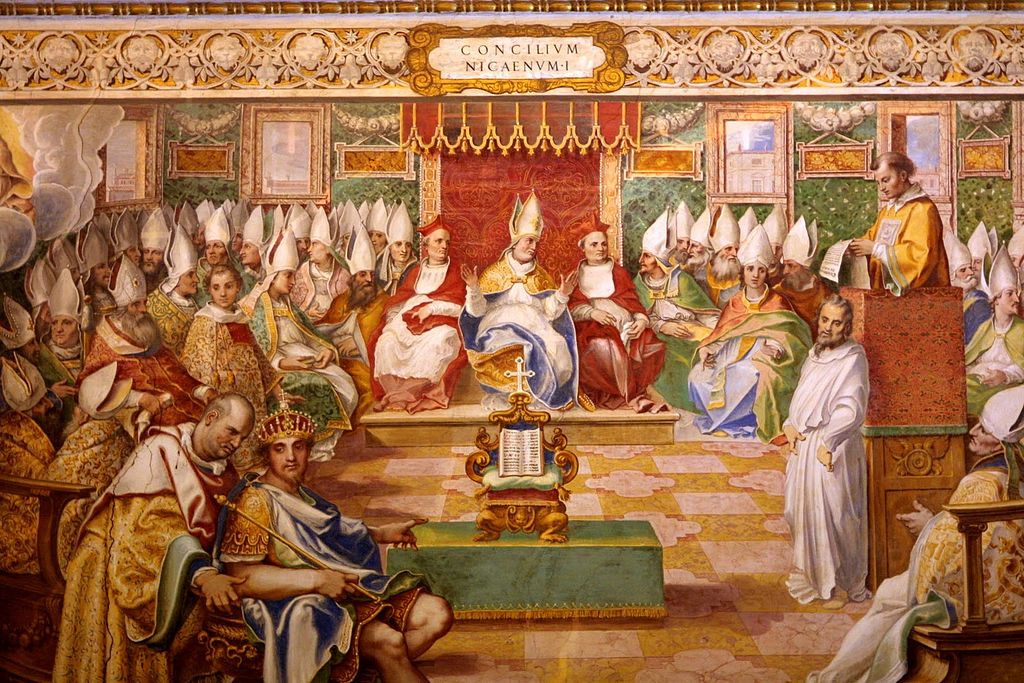
Council of Nicea Fresco in Capella Sistina, Vatican (Public Domain)
Excerpts from Anglican Canon Charles Gore, Dissertations on Subjects Connected with the Incarnation (London: John Murray, 1895), pages 171-2, 173.
The earlier mediaeval and scholastic method appears to put the dogmas of the Church in a wrong place. The dogmas are primarily intended as limits of ecclesiastical thought rather than as its premises: they are the hedge rather than the pasture-ground: they block us off from lines of error rather than edify us in the truth. By them we are warned that Christ is no inferior being but very God; and that He became at His Incarnation completely man, not in body only but in mind and spirit; . . . But thus warned off from cardinal errors, we are sent back to the New Testament, especially to the Gospels, to edify ourselves in the positive conception of what the Incarnation really meant. To Irenaeus, to Origen, to Athanasius, the New Testament is the real pasture-ground of the soul, and the function of the Church is conceived to be to keep men to it. But after a time there comes a change. The dogmas are used as the positive premises of thought. The truth about Christ’s person is formed deductively and logically from the dogmas whether decrees of councils or popes, or sayings of great fathers which are ranked as authoritative and the figure in the Gospels grows dim in the background. Particular texts from the Gospels which seem contrary to current ecclesiastical teaching are quoted and requoted, but though, taken together, they might have availed to restore a more historical image of the divine person incarnate, in fact they are taken one by one and explained away with an ingenuity which excites in equal degrees our admiration of the logical skill of the disputant and our sense of the lamentably low ebb at which the true and continuous interpretation of the Gospel documents obviously lies.
. . . .
. . . Greek philosophy was primarily concerned to conceive of God metaphysically. He was the One in opposition to the many objects of sense, and the Absolute and Unchangeable in opposition to the relative and mutable. In particular the divine immutability had a meaning assigned to it very different from that which belongs to it in the Bible, a meaning determined by contrast, not to the changeableness of human purpose, but to the very idea of motion which, as belonging to the material, was also supposed to be of the nature of the evil. There is no doubt that this Greek metaphysical conception of God influenced Christian theology largely and not only for good. In particular, through the medium of Neo-Platonism, it deeply coloured the thought of that remarkable and anonymous author who, writing about A.D. 500, passed himself off, probably without any intention to deceive, as Dionysius the Areopagite, the convert of St. Paul. With him the metaphysical conceptions of the transcendence, incomprehensibility, absolute unity and immutability of God are a master passion. In his general philosophy the result of his zeal for the One is to lead him to ascribe to the manifold life of the universe only a precarious reality. In his view of the Incarnation it produces at least a monophysite [sort of Unitarian or Monarchian] tendency.
How the Ancient and Medieval Church became Neoplatonist
Posted: October 3, 2017 Filed under: Uncategorized Leave a comment
The School of Athens, from Plato to Plotinus
Passages quoted from William Fairweather, Origen and Greek Patristic Theology (NY: Charles Scribner’s Sons, 1901).
(pp. 6-8)
The situation of the Alexandrian Christians was thus in many respects unique. They witnessed the fragments of the old systems gathered together to produce, through the introduction of Platonic ideas, a revived and spiritualised paganism in opposition to Christianity, for the ushering in of Neoplatonism by Ammonius [Saccas] constituted the last prop of the old world. If, however, we think to find in the writings of the Alexandrian teachers a systematic refutation of Neoplatonism in its various principles, we shall be disappointed. So, too, if we look for a definite position against Christianity in the works of Platonists. Neither system was as yet sufficiently developed to admit of this. But there was between the two systems an essential difference at bottom, and the real conflict for the Church lay in its being forced very much to leave its own standpoint and adopt that of its opponents. To combat Platonism it must needs accommodate itself to philosophy, and in submitting to this it became fettered with philosophical adjuncts to a dangerously suicidal extent. . . . . That errors, mystical, speculative, allegorical, and pagan, began to choke it like so many weeds, is clear from the works of the men who, from their position as prefects of the Catechetical School, necessarily became apologists for Christianity. All of them were more or less tinctured with Platonic views. They were themselves philosophers, and so could sympathise with their opponents, whose error they were disposed to view rather as one of defect than as a total perversion of truth. In this way they were led to overestimate the similarity between pagan and Christian wisdom. Prior to the latter part of the second century Christian teaching, with very few exceptions, had been true to apostolic example; but after philosophers embraced Christianity, and the new Platonism, which allied itself to Orientalism, began to exert its influence, the case was altered. The intellectual was frequently represented as the chief or only side of Christianity to be attended to; it was regarded not so much as a rule of life as a speculative scheme of doctrine. From this the transition was easy to “mysteries” similar to those of heathenism. Certain views were kept secret as a higher species of doctrine suitable only for the cultivated few. An attempt was made, in short, to provide the gospel with a philosophy, and to resolve it into such a system as philosophers would embrace.
Nor is the explanation of all this far to seek. It may at first sight seem strange that Christian teachers could embrace doctrines known to be Platonic, but we must recollect that these same doctrines were supposed to have been borrowed from Holy Scripture, which they believed to be the revelation of God’s wisdom to men. Speculative theologians, moreover, have always been influenced by contemporary philosophy, and these Alexandrian Fathers only sought to express the doctrines of the faith in a form adapted to the spirit of the times. Men like Justin and Clement had themselves passed over from heathen philosophy, and naturally carried with them much of its influence; but they had nevertheless an ardent desire to see Christian truth in its right place. . . . . After all, the Alexandrian Fathers “did not exchange the gospel for Ncoplatonism.” They resolutely maintained the supreme authority of Holy Scripture; and with whatever distortions and incongruities it may have been associated, the assertion of this principle of an objective rule of faith was in itself of the utmost value in combating a philosophy of which the only standard lay in the subjective notions of its advocates.
(p. 23)
By the light which it threw upon the great problems raised by philosophy regarding God, the world, and the human soul, Christianity had awakened the dormant spiritual sense in vast multitudes of men. But in the matter of satisfying the spiritual needs of humanity it found a rival claimant in Neoplatonism, which took for its religious ideal the direct apprehension of the divine essence. Thus, it was believed, would the traditional worship receive a new impetus, and the desideratum, for want of which men were seceding to Christianity, be supplied. The promoters of Neoplatonism saw that if heathenism was to prevail, it must both get rid of its more glaring absurdities, and also strengthen itself by a large accession of ideas, principles, and rites. Thus they borrowed whatever appeared to them good from every available source. They contemplated nothing less than the introduction of a universal religion, constructed on principles so broad that the wise of all the earth could adhere to it. It was their aim to set matters right between philosophy and theology, between doctrine and life, and to satisfy the needs of the soul on a scale to which Christianity could make no pretension.
(p. 74)
Origen finds his ruling principle of interpretation in Prov. xxii. 20 (LXX), and in an analogy between the Platonic doctrine of the constitution of man and Scripture, which has been given for man’s salvation. As man is of a tripartite nature, consisting of body, soul, and spirit, so also does Scripture possess a threefold sense—the literal, the moral, and the spiritual.
(p. 77)
What led Origen thus to repudiate tlie literal sense of so many passages of Scripture? In general, it may be said that his Platonic spiritualism, his attachment to the Alexandrian idea of gnosis, and his extravagant conception of inspiration already predisposed him in favour of a mystical exegesis.
(p. 87)
The character of Origen’s theological system as a philosophy of revelation accounts for the Gnostic and Neoplatonic features mixed up with it. His speculations often recall the theosophic dreams and fantastic cosmology of Valentinus, and his methods are those of that prominent heresiarch, and of the Neoplatonic schools. In his doctrine of the pre-existence of souls, in his theory of a threefold division of human nature, and in his highly symbolic interpretation of the story of Paradise, his Christian theology clearly shows affinity with those systems. The agreement, however, is not in principle, but is due to the adoption in common of particular Platonic tenets. He is even more of an idealistic philosopher than Plato himself.
(pp. 92 f.)
The moral and religious ideal set forth in the system of Origen is one which has its roots partly in Neoplatonic mysticism and partly in Holy Scripture. It had long been a favourite theory with idealistic philosophers that the most perfect life open to man is that which consists solely in meditative introspection and contemplation of the eternal. According to this view actions have the effect of entangling us in all manner of worldly concerns, and therefore it is better for us not to act, but just to remain absorbed in the absolute and the unseen, and in the possession of a calm tranquility which more than anything else tends to make us godlike. To have need of nothing is to be in closest contact with the Deity; to overcome the sensuous, and to live in the habitual contemplation of the invisible, is to attain at length the final aim of existence in ecstatic union with God. This is the view of life that prompted the ancient hermits to withdraw from the world and take to their cells, and it is this that has laid the foundation of the monastic system wherever it has been practised. Whether, however, this abandonment of the active for the contemplative life is in harmony with the truo genius of Christianity may well be doubted; its note is not that of an isolated self-sufficiency, but that of a yearning aspiration after righteousness. In the Alexandrian Fathers we see the union of both tendencies.
(p. 107)
Both [Origen and Celsus] were Platonists, but with a difference.
(p. 215)
Indeed the tide [of Origenism], instead of flowing, began to ebb, and after the time of Theognostus its adherents were obliged to assume the defensive. Partly this was due to the rival attractions of Neoplatonism, which at the commencement of the fourth century became the prevailing philosophy in Christian as well as in pagan circles, and partly to the circumstance that the Church was wholly engrossed with debates upon one particular subject—that of the Trinity, and could not give a thought to the elaborate philosophy of Origenism.
(p. 257)
Enough has been said to show that Origen’s influence upon succeeding ages was by no means commensurate with the boldness and grandeur of his system. This may be accounted for in several ways. For one thing it was not “compactly built together”; through its looseness and discursiveness it was at a disadvantage as compared with the more firmly welded Neoplatonism of Plotinus.
(p. 258)
Not until the ninth century did any gleam of his influence appear; and if three centuries later it manifested itself with greater strength in the pages of Duns Scotus, it was overlaid and virtually stifled with Neoplatonic mysticism drawn from the pseudo-Dionysius the Areopagite.
How the Church became Sacerdotal instead of Spiritual
Posted: April 23, 2016 Filed under: Church History, Historical Theology, Spirituality | Tags: mass, priest, priesthood, ritual, sacerdotal, sacerdotalism, sacrament, sacramentalism Leave a comment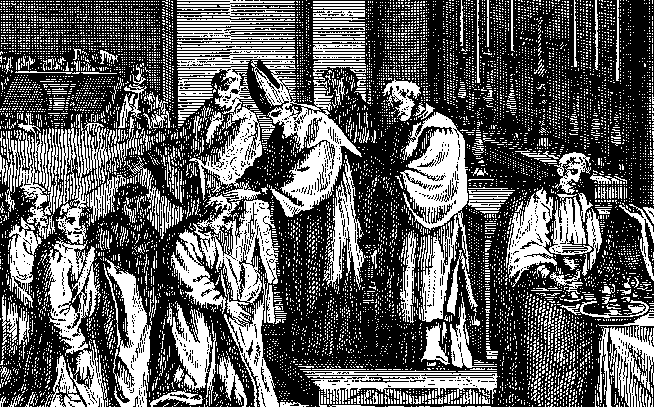
Public Domain
Excerpt from Hugh M. Scott, Origin and Development of the Nicene Theology: With Some Reference to the Ritschlian View of Theology and History of Doctrine (Chicago Theological Seminary Press, 1896), pp. 250 f.
The loss of the gospel conception of personal, living union throughout life of the believer with the exalted Christ was followed inevitably by the wrong soteriology of the early Church: (1) Because He was not felt to be the head of every Christian man and every congregation, bishops and other heads arose. (2) Because direct personal communion with Him was obscured, the Church and the Sacraments came in between the soul and the Saviour, thus not only bringing in a hierarchy but perverting the whole conception of man’s relation to Christ. (3) Because constant, direct approach to Christ was lost, a thousand indirect approaches by washings, fastings, visions, ascetic practices, confessions, came into use. (4) Because the witness of Christ by His Spirit in the heart was largely overlooked, too much stress was laid upon intellectual forms of faith, philosophical proofs of Christianity, and theological creeds. (5) This loss of the present Christ in the midst of the worshiping congregation was followed by a more formal worship, in which liturgies, elaborate ceremonies, and theological statements, too much took the place of the free charismatic prayers and teachings of the primitive Church. (6) In life also, as the thought was obscured that Christ dwells in each believer, a loss of holiness followed. To have the rules of the Church, to follow her discipline, was a lower standard than to “have the mind of Christ.” From the individual this view spread to the Church. For the New Testament, believers were a temple of God; for Callixtus, the Church was the ark of Noah, full of both clean and unclean creatures. (7) Finally, this loss of Christ as King in each Christian changed the whole missionary character of the Church. Instead of all preaching — let him that heareth say, come” — the clergy preached and the laity listened; or monks went out, spreading their defective views of Christianity.
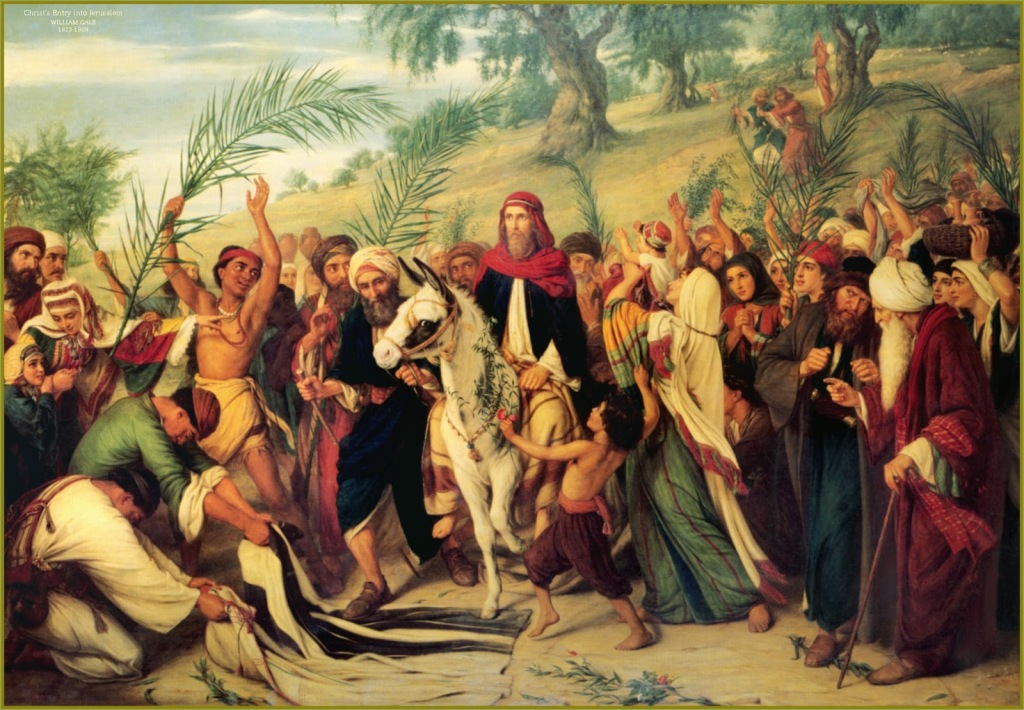
Recent Comments